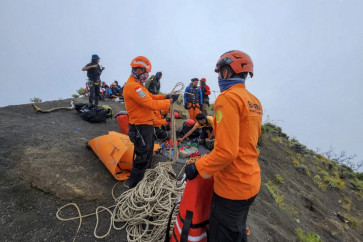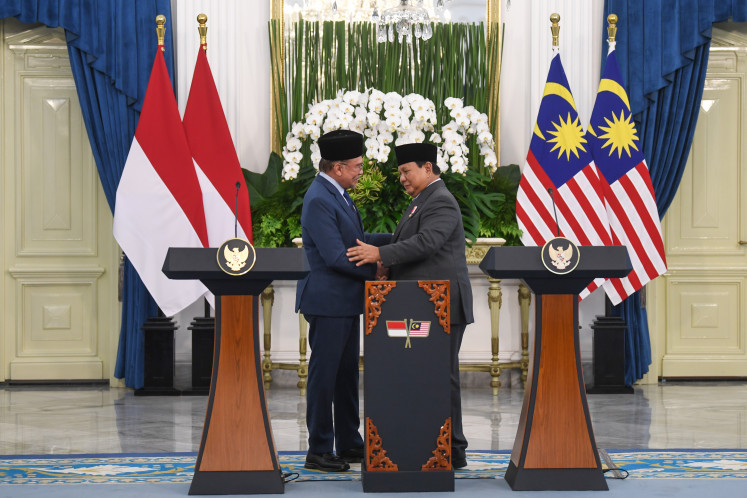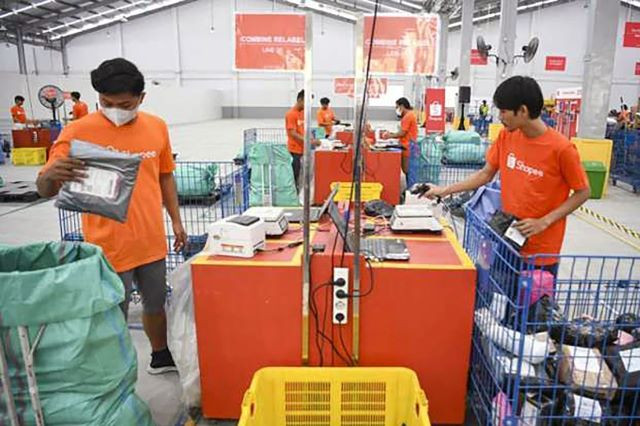Popular Reads
Top Results
Can't find what you're looking for?
View all search resultsPopular Reads
Top Results
Can't find what you're looking for?
View all search resultsThe economics of ‘qurban’ and efforts to address the income gap
The income disparity is evident in the consumption of essential but expensive food items such as meat, which is unaffordable for the lower-income population.
Change text size
Gift Premium Articles
to Anyone

F
or Indonesian Muslims, qurban (sacrifice), which will be performed this week, is not just a religious ritual but also a significant social-economic tradition. Being the world’s largest majority Muslim nation, Indonesia has substantial potential in the qurban sector. Properly managed, it can boost economic growth, improve the welfare of the less fortunate and empower small-scale livestock farmers.
The Institute for Demographic and Poverty Studies (IDEAS) projects that Indonesia's qurban economic potential for 2023 is estimated at Rp 24.5 trillion (US$1.6 billion), involving 2.08 million shahibul qurban (those performing the qurban ritual). Although slightly lower than the previous year's estimate of Rp 24.3 trillion from 2.17 million shahibul qurban, this projection considers the lingering effects of the global recession.
Out of the 2.08 million high-income Muslim families, the highest demand for sacrificial animals is for goats and sheep (1.23 million) and cattle and buffalo (approximately 505,000). These animals, with varying weight ranges, have the potential to produce around 103,000 tonnes of meat.
Java Island, particularly urban areas like Greater Jakarta, Greater Bandung, Greater Surabaya, Yogyakarta, Malang and Semarang, presents the largest qurban potential due to its concentration of middle-class Muslims with strong purchasing power.
Indonesia has long experienced a wide food consumption gap rooted in income inequality. This disparity is evident in the consumption of essential but expensive food items such as meat, which is unaffordable for the lower-income population. In 2022, the highest percentile (1 percent of the wealthiest) consumed an average of 5.31 kilograms of goat and beef per capita per year, 294 times higher than the lowest percentile (1 percent of the poorest) consuming only 0.02 kg of meat per capita per year.
In this context, qurban plays a crucial role for the impoverished. It has the potential to improve their access to expensive essential food items. More equitable access will reduce the level of meat consumption inequality.
In 2022, we identified at least 74.2 million mustahik (those eligible to receive qurban meat) who belong to the group with the lowest meat consumption and are thus most deserving of qurban meat. The prioritized mustahik include 5.2 million extremely poor individuals (below 0.8 poverty line/PL), 11.4 million poor mustahik (0.8 - 1.0 PL), 16.5 million near-poor mustahik (1.0 to 1.2 PL) and 41.1 million vulnerable poor mustahik (1.2 to 1.6 PL).
Overall, the middle class also has low meat consumption similar to the lower class and, therefore, deserves an allocation of qurban meat. However, it is suspected that the middle class has a higher consumption of processed meats such as meatballs, nuggets, sausages, as well as poultry, especially chicken and fish.
If we can accurately target the 74.2 million priority mustahik, with lower-income mustahik receiving a larger share of qurban meat, the meat consumption gap can potentially be significantly reduced. Our simulations indicate that with proper social engineering in qurban meat distribution, allowing perfect targeting of the 74.2 million priority mustahik, the measured meat consumption inequality, as represented by the Gini ratio, has the potential to decrease significantly from 0.61 to 0.38
High-quality food is crucial for human growth. Meat, eggs and milk provide essential nutrients. Inadequate meat consumption negatively affects nutrition, especially in children, impacting their intelligence and future socioeconomic status. Qurban, with a potential of 103,000 tonnes of meat, can improve nutrition, particularly for the poorest. However, qurban potential and recipients are unevenly distributed, concentrated in rural areas of Java and beyond.
The meat consumption gap in Indonesia is not only present between different economic classes but also across regions. For instance, in 2022 the average meat consumption in the city of Padang Panjang in West Sumatra was 2.147 kg per capita per year, 262 times higher than in the regency of West Nias in North Sumatra, which recorded only 0.008 kg per capita per year.
Sharp meat consumption disparities also exist within Java. For example, in 2022 the average meat consumption in East Jakarta was 2.779 kg per capita per year, 112 times higher than in the regency of Ngawi in East Java, which recorded only 0.025 kg per capita per year.
Without social engineering, qurban meat distribution tends to circulate in regions with already high meat consumption. The gap between qurban potential and demand leads to uneven distribution.
By comparing the potential and demand for qurban meat, three typologies of regions can be identified.
First, surplus regions like the city of Bandung produce 3,257 tonnes of qurban meat potential while only needing 884 tonnes for mustahik, resulting in a surplus potential of 2,374 tonnes.
Second, deficit regions like Brebes regency in Central Java have the potential to produce only 335 tonnes of qurban meat while needing 1,240 tonnes for mustahik, resulting in a deficit potential of 905 tonnes.
Third, neutral regions like Malang in East Java have the potential to produce 1,210 tonnes of qurban meat, which is almost equal to the mustahik's demand of 1,157 tonnes. Therefore, significant mismatch potential in qurban meat distribution exists without social engineering.
We identified priority regions for protein intervention through qurban, focusing on areas with very low or near-zero meat consumption and a large number of mustahik. These priority intervention regions in 2022 were predominantly located outside Java and characterized by underdevelopment and isolation, such as Majene, West Seram and North Hulu Sungai regencies. However, several regions in Java, such as Ngawi and Pandeglang, were also categorized as priority intervention areas.
Our simulations indicate that regions with the largest surplus potential for qurban meat are dominated by metropolitan areas in Java, including Jakarta (7,556 tonnes) and Greater Bandung, which includes Bandung, Cimahi and Sumedang (5,598 tonnes). Other regions with significant surplus potential include Bekasi (3,820 tonnes), Bogor and Depok (3,298 tonnes), Sleman and Bantul regencies in Yogyakarta (2,924 tonnes), Tangerang and South Tangerang (2,045 tonnes), Semarang (1,763 tonnes) and Surabaya and neighboring Sidoarjo (1,131 tonnes).
On the other hand, regions with the largest deficit potential for qurban meat are predominantly rural areas in Java, such as the northern region of Central Java, the northern region of East Java, the eastern region of East Java, and the northern part of West Java.
Widespread poverty in Java necessitates accurate identification of mustahik for qurban management, while poverty in regions outside Java requires strong efforts to open access to remote and isolated areas. Thus, precise qurban distribution to those most deserving becomes crucial and a key indicator of successful qurban implementation.
Perfect targeting, accompanied by varying the amount of qurban meat according to mustahik's needs, can optimize the benefits of qurban meat.
***
Yusuf Wibisono is the executive director of the Institute for Demographic and Poverty Studies (IDEAS), where Askar Muhammad and Shofie Azzahrah are a research associate and an economist respectively.









